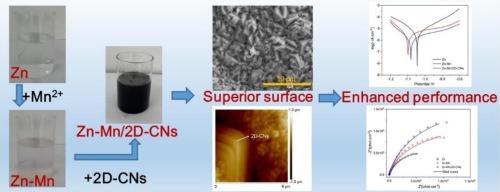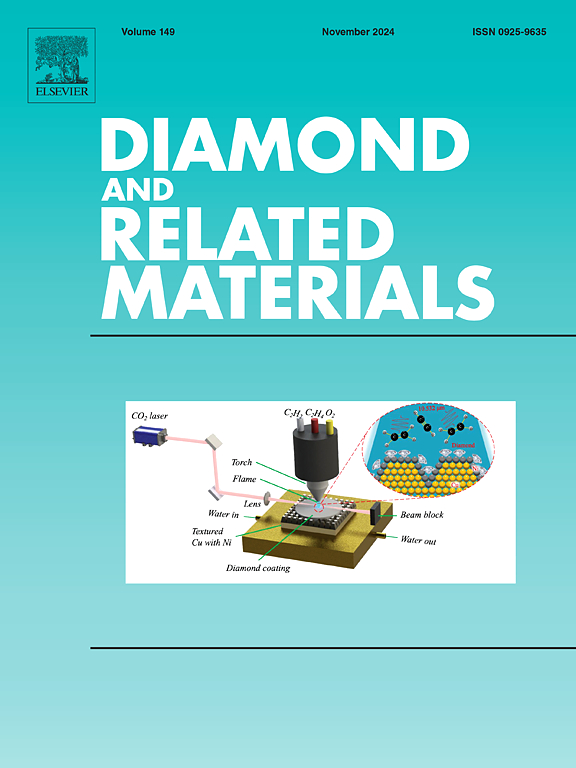与二维碳纳米颗粒共沉积的 Zn-Mn 复合涂层可提高耐腐蚀性能
IF 4.3
3区 材料科学
Q2 MATERIALS SCIENCE, COATINGS & FILMS
引用次数: 0
摘要
锌涂层是碳钢的一种典型防腐蚀涂层。考虑到 Zn 涂层的牺牲性质,在实际应用中必须增强其耐腐蚀性,以保证其长期性能。本研究采用简单的电沉积方法,成功地在低碳钢上共沉积了纳米厚度(∼100 nm)、超大横向尺寸(10-40 μm)的二维纳米碳板(2D-CNs)和锰元素。结果表明,Zn-Mn/二维氯化锰复合镀层由 Zn 相、ZnMn3 相和少量二维氯化锰组成。与 Zn 涂层(Ra = 798 nm,Rq = 684 nm)相比,Zn-Mn/2D-CNs 复合涂层的表面质量有所改善,具有超细晶粒和较小的粗糙度(Ra = 176 nm,Rq = 131 nm)。此外,复合涂层中的惰性二维氯化萘可以起到腐蚀屏障的作用。因此,Zn-Mn/2D-CNs 复合涂层具有优异的防腐蚀性能,其腐蚀电流密度 icorr(9.2 μA cm-2)最低,涂层电阻 Rcoat(1.2 kΩ-cm-2)和电荷转移电阻 Rct(3.5 kΩ-cm-2)最大,这与其改良的微观结构、具有钝化特性的锰元素和 2D-CNs 屏障有关。这些结果表明,在锌基涂层的电沉积过程中,惰性二维碳材料具有提高耐腐蚀性的理想潜力。本文章由计算机程序翻译,如有差异,请以英文原文为准。

Zn-Mn composite coating codeposited with two-dimensional carbon nanoplatelets for improving corrosion resistance
Zn coating is a typical anti-corrosion coating for carbon steel. Considering the sacrificial nature of Zn coating, it is essential to enhance the corrosion resistance for the long-term performance in the practical application. In this work, two-dimensional carbon nanoplatelets (2D-CNs) with nanometer thickness (∼100 nm) and ultra-large lateral size (10–40 μm) and Mn element have been successfully co-deposited with Zn onto low carbon steel by a simple electrodeposition method. Results show that the Zn-Mn/2D-CNs composite coating is composed of Zn phase, ZnMn3 phase and a small number of 2D-CNs. The Zn-Mn/2D-CNs composite coating exhibits a modified surface quality with ultrafine grains and smaller roughness (Ra = 176 nm, Rq = 131 nm) when compared with that of Zn coatings (Ra = 798 nm, Rq = 684 nm). Besides, the inert 2D-CNs within the composite coating can act as the corrosion barriers. Therefore, the Zn-Mn/2D-CNs composite coating has excellent anti-corrosion performance, owning the lowest corrosion current densities icorr (9.2 μA cm−2) and maximum coating resistance Rcoat (1.2 kΩ·cm−2) and charge transfer resistance Rct (3.5 kΩ·cm−2), associated with its modified microstructure, Mn element with passivation property, and 2D-CNs barriers. These results demonstrate the desirable potentiality of inert 2D carbon materials in the electrodeposition of Zn-based coating for improving the corrosion resistance.
求助全文
通过发布文献求助,成功后即可免费获取论文全文。
去求助
来源期刊

Diamond and Related Materials
工程技术-材料科学:综合
CiteScore
6.00
自引率
14.60%
发文量
702
审稿时长
2.1 months
期刊介绍:
DRM is a leading international journal that publishes new fundamental and applied research on all forms of diamond, the integration of diamond with other advanced materials and development of technologies exploiting diamond. The synthesis, characterization and processing of single crystal diamond, polycrystalline films, nanodiamond powders and heterostructures with other advanced materials are encouraged topics for technical and review articles. In addition to diamond, the journal publishes manuscripts on the synthesis, characterization and application of other related materials including diamond-like carbons, carbon nanotubes, graphene, and boron and carbon nitrides. Articles are sought on the chemical functionalization of diamond and related materials as well as their use in electrochemistry, energy storage and conversion, chemical and biological sensing, imaging, thermal management, photonic and quantum applications, electron emission and electronic devices.
The International Conference on Diamond and Carbon Materials has evolved into the largest and most well attended forum in the field of diamond, providing a forum to showcase the latest results in the science and technology of diamond and other carbon materials such as carbon nanotubes, graphene, and diamond-like carbon. Run annually in association with Diamond and Related Materials the conference provides junior and established researchers the opportunity to exchange the latest results ranging from fundamental physical and chemical concepts to applied research focusing on the next generation carbon-based devices.
 求助内容:
求助内容: 应助结果提醒方式:
应助结果提醒方式:


